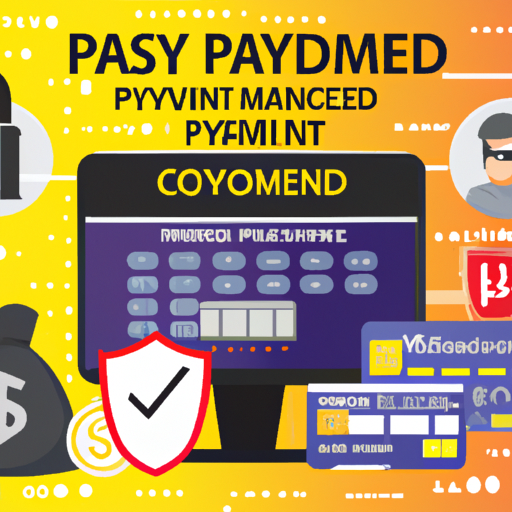-
Table of Contents
- Introduction
- Best Practices for Payment Security and Protection Against Fraud
- Understanding the Different Types of Payment Fraud
- The Latest Payment Security Technologies and Their Impact on Businesses
- How to Protect Your Business from Payment Fraud
- The Benefits of Implementing Payment Security Solutions
- Conclusion
“Secure Payments, Secure Future: Protecting You from Payment Fraud”
Introduction
Payment security and protection against payment fraud is an important issue for businesses and consumers alike. With the rise of online payments, the risk of fraud has increased significantly. Payment security is the process of protecting payments from unauthorized access, use, or disclosure. It involves the use of various technologies, processes, and procedures to ensure that payments are secure and protected from fraud. Payment security also includes measures to protect against identity theft, data breaches, and other forms of fraud. Payment security is essential for businesses to protect their customers and their own financial interests. It is also important for consumers to ensure that their payments are secure and protected from fraud.
Best Practices for Payment Security and Protection Against Fraud
Payment security and protection against fraud are essential for businesses of all sizes. To ensure the safety of customers’ financial information and protect against fraudulent activity, businesses should follow best practices for payment security.
First, businesses should use secure payment processing systems. This includes using secure payment gateways, encrypting data, and using tokenization. Secure payment gateways provide an extra layer of security by verifying customer information and preventing unauthorized access to payment information. Encryption scrambles data so that it is unreadable to anyone who does not have the encryption key. Tokenization replaces sensitive data with a unique identifier, making it impossible for hackers to access the original data.
Second, businesses should use fraud prevention tools. These tools can detect suspicious activity and alert businesses to potential fraud. Examples of fraud prevention tools include address verification, card verification value (CVV) checks, and 3D secure authentication. Address verification checks the billing address provided by the customer against the address on file with the credit card issuer. CVV checks require customers to enter the three-digit code on the back of their credit card. 3D secure authentication requires customers to enter a one-time password sent to their mobile device.
Third, businesses should use secure payment methods. This includes using payment methods that are PCI compliant, such as credit cards, debit cards, and e-wallets. PCI compliance means that the payment method meets the Payment Card Industry Data Security Standard (PCI DSS). This standard sets out the requirements for protecting customer data and preventing fraud.
Finally, businesses should educate their customers about payment security. This includes providing information about the security measures in place to protect their data and how to recognize and report suspicious activity. Businesses should also encourage customers to use strong passwords and two-factor authentication when making payments.
By following these best practices for payment security and protection against fraud, businesses can ensure the safety of their customers’ financial information and protect against fraudulent activity.
Understanding the Different Types of Payment Fraud
Payment fraud is a growing problem in the digital age. It is estimated that businesses lose billions of dollars each year due to fraudulent payments. As such, it is important to understand the different types of payment fraud and how to protect yourself from them.
One of the most common types of payment fraud is identity theft. This occurs when someone obtains your personal information, such as your credit card number or bank account information, and uses it to make unauthorized purchases or withdrawals. Identity theft can be particularly damaging, as it can lead to long-term financial damage.
Another type of payment fraud is account takeover. This occurs when someone gains access to your account and makes unauthorized transactions. This can be done through phishing emails, malware, or other malicious means.
A third type of payment fraud is card skimming. This occurs when someone uses a device to copy the information from the magnetic strip on your credit or debit card. The information is then used to make unauthorized purchases or withdrawals.
Finally, there is payment fraud through counterfeit cards. This occurs when someone creates a fake card with your information and uses it to make purchases or withdrawals.
It is important to be aware of these different types of payment fraud and take steps to protect yourself. Make sure to keep your personal information secure, use strong passwords, and be wary of suspicious emails or websites. Additionally, you should monitor your accounts regularly and report any suspicious activity to your financial institution. By taking these steps, you can help protect yourself from payment fraud.
The Latest Payment Security Technologies and Their Impact on Businesses
The payment security landscape is constantly evolving, and businesses must stay abreast of the latest technologies to ensure their customers’ data is secure. This article will discuss the latest payment security technologies and their impact on businesses.
One of the most important payment security technologies is tokenization. Tokenization is a process that replaces sensitive payment data with a unique identifier, or token. This token is used to process payments without exposing the customer’s actual payment information. Tokenization helps to reduce the risk of data breaches and fraud, as the customer’s payment information is not stored in the merchant’s system.
Another important payment security technology is point-to-point encryption (P2PE). P2PE is a process that encrypts payment data from the point of entry to the point of authorization. This ensures that the customer’s payment information is secure throughout the entire transaction process. P2PE also helps to reduce the risk of data breaches and fraud, as the customer’s payment information is not stored in the merchant’s system.
Finally, businesses should also consider using 3-D Secure (3DS) technology. 3DS is a protocol that adds an extra layer of security to online payments. It requires customers to authenticate their identity before completing a transaction, which helps to reduce the risk of fraud.
The use of these payment security technologies can have a positive impact on businesses. By implementing these technologies, businesses can reduce the risk of data breaches and fraud, which can help to protect their customers’ data and improve customer trust. Additionally, businesses can benefit from reduced costs associated with fraud prevention and data security.
In conclusion, businesses must stay abreast of the latest payment security technologies to ensure their customers’ data is secure. Tokenization, point-to-point encryption, and 3-D Secure are all important technologies that can help to reduce the risk of data breaches and fraud. The use of these technologies can have a positive impact on businesses, as they can help to protect their customers’ data and reduce costs associated with fraud prevention and data security.
How to Protect Your Business from Payment Fraud
Payment fraud is a serious threat to businesses of all sizes. It can cause financial losses, damage to your reputation, and even legal issues. Fortunately, there are steps you can take to protect your business from payment fraud.
First, it’s important to understand the different types of payment fraud. Common types include credit card fraud, identity theft, and phishing. Credit card fraud occurs when someone uses a stolen or counterfeit credit card to make purchases. Identity theft occurs when someone uses another person’s personal information to make purchases. Phishing is when someone attempts to obtain sensitive information, such as passwords or credit card numbers, by posing as a legitimate business.
Once you understand the different types of payment fraud, you can take steps to protect your business. Here are some tips:
• Use secure payment processing systems. Make sure your payment processing system is up-to-date and secure. This will help protect your customers’ data and reduce the risk of fraud.
• Verify customer information. Before processing a payment, verify the customer’s identity and billing information. This will help ensure that the payment is legitimate.
• Monitor transactions. Monitor your transactions for suspicious activity. If you notice anything out of the ordinary, contact your payment processor immediately.
• Educate your staff. Make sure your staff is aware of the different types of payment fraud and how to spot it.
By following these tips, you can help protect your business from payment fraud. Remember, the best defense is a good offense. Take the necessary steps to protect your business and your customers.
The Benefits of Implementing Payment Security Solutions
Payment security solutions are becoming increasingly important for businesses of all sizes. Implementing these solutions can provide a number of benefits, including improved customer trust, increased data security, and reduced costs.
First and foremost, implementing payment security solutions can help to build customer trust. Customers are increasingly concerned about the security of their data, and they want to be sure that their information is safe when they make a purchase. By implementing payment security solutions, businesses can demonstrate to customers that they take data security seriously and that their data is protected. This can help to build customer trust and loyalty, which can lead to increased sales and customer retention.
Second, payment security solutions can help to protect customer data from potential breaches. By encrypting customer data and using other security measures, businesses can reduce the risk of a data breach. This can help to protect customer data from malicious actors and reduce the risk of financial losses due to fraud or identity theft.
Finally, payment security solutions can help to reduce costs. By reducing the risk of a data breach, businesses can save money on the costs associated with responding to a breach. Additionally, businesses can save money on the costs associated with fraud prevention and identity theft.
In conclusion, implementing payment security solutions can provide a number of benefits, including improved customer trust, increased data security, and reduced costs. Businesses of all sizes should consider implementing these solutions to protect their customers and their data.
Conclusion
Payment security and protection against payment fraud is an important issue that needs to be addressed. By implementing the right security measures, businesses can protect their customers and their own assets from fraud. This includes using secure payment methods, such as encryption and tokenization, as well as implementing fraud prevention measures, such as monitoring customer activity and using fraud detection software. By taking these steps, businesses can ensure that their customers’ payments are secure and that their own assets are protected from fraud.




